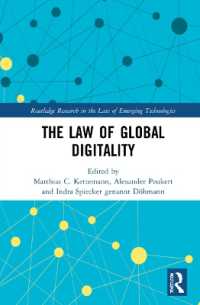Full Description
This open access book shows how to design labour rights to effectively protect digital platform workers, organise accountability on digital work platforms, and guarantee workers' collective representation and action. It acknowledges that digital work platforms entail enormous risks for workers, and at the same time it reveals the extent to which labour law is in need of reconstruction.
The book focusses on the conceptual links - often overlooked in the past - between labour law's categories and its regulatory approaches. By explaining and analysing the wealth of approaches that deconstruct and reconceptualise labour law, the book uncovers the organisational ideas that permeate labour law's categories as well as its policy approaches in a variety of jurisdictions. These ideas reveal a lack of fit between labour law's traditional concepts and digital platform work: digital work platforms rarely behave like hierarchical organisations; instead, they more often function as market organisers.
The book provides a fresh perspective for international academic and policy debates on the regulation of digital work platforms, as well as on the purposes and foundations of labour law. It offers a way out of the impasse the debate around labour law classification has reached, by showing what labour law could learn from digital law approaches to platforms - and vice versa.
The ebook editions of this book are available open access under a CC BY-NC-ND 4.0 licence on bloomsburycollections.com.
Contents
1. Introduction: Just Another Technical Revolution?
1.1. Labour Law for YouTubers?
1.2. What is this Book About?
1.3. Outline of this Book
1.4. Building on Research Experiences from Germany
1.5. Some Notes on Language and Terminology
2. Digital Work Platforms as Objects of Regulation
2.1. The Concept of Regulatory Domains
2.2. Labour Law in Competition with Other Regulatory Domains
2.3. Digital Law: A New Regulatory Domain?
2.4. Digital Platforms: More than Matchmakers?
2.5. The Interface: Digital Work Platforms
3. Fitting Pegs into Holes: Classification in Labour Law
3.1. Labour Law Categories
3.2. A Cross-national Analysis of Employment Classification
3.3. The Typological Method
3.4. Descriptions and Indicators for Employment
3.5. Jiggling the Peg: Digital Platform Work as Employment?
3.6. Results: Transcendental Nonsense?
4. Theoretical Foundations of Employment Classification
4.1. Deconstruction and Reconceptualisation of Categories
4.2. Justifying Labour Rights
4.3. Functions and Purposes of Labour Law: Focus on Employers' Powers
4.4. Results
5. Digital Work Platforms as Organisations
5.1. Organisation and Market in Organisation Theories
5.2. New Concepts: Between Market and Organisation?
5.3. Digital Work Platforms as Market Organisers
5.4. Results: 'Something Old, Something New'
6. Labour Law Categories for Workers on Market Organising Platforms
6.1. Identifying Market Organisers
6.2. Techniques for Regulating Categories
6.3. A New Category?
6.4. Courts or Legislators?
6.5. Further Sectoral Differentiation?
6.6. Results
7. Enabling Workers and Holding Platforms Accountable
7.1. Policy Proposals: Examples and Frameworks
7.2. Independent of Classification Status: Universal Social Rights
7.3. Independent of Classification Status: Fair Contracts
7.4. Labour Rights for Non-Employees
7.5. Making Market Organisers Accountable for Labour Rights
7.6. Collective Rights for Workers on Organised Markets
7.7. Results and Outlook
7.8. The Challenge of Transnationality
8. Results and Conclusions
8.1. Results
8.2. Labour Law and the Law of the Labour Market
8.3. A Quarry of Regulatory Ideas






